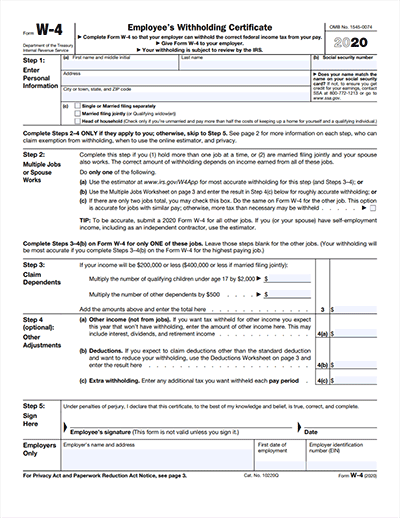How Taxpayers Estimated Withholdings Previously
When a company hires an employee, the company is required to withhold certain taxes from each paycheck for the employee, deposit the money to the IRS, and file payroll reports (forms 941, W2, etc.). The company acts as an agent for the government to collect taxes throughout the year.
Since no one can predict how much money each employee will earn or how much income tax the employee needs to pay until the end of the year, the withholding amount for income tax is an estimate of the actual tax liability, which is determined when the employee files their 1040 tax return. The employee will then either receive a refund or need to pay additional taxes.
For many years, the W-4 form lists a “total number of allowances,” a number loosely understood as dependents. When the income tax withholding is calculated for each paycheck, the allowance number, marital status and pay-cycle determine how much to withhold to meet the estimated tax obligation. There are worksheets and procedures that an employee can use to calculate the proper number of allowances to use.
The right goal is to pay (or pre-pay) a sufficient amount of tax from each paycheck to avoid a large tax bill and avoid possible penalties and interest. On the other hand, if the withholding amount is too much, the taxpayer will get a large refund. Refunds may feel good, but it’s not financially smart. The taxpayer is basically giving an “interest-free” loan to the government.
Using the “number of allowances” method, about 73% of all taxpayers receive a refund for tax year 2018 at an average of over $2,500 dollars each. Historically, most employees are withholding more for income tax than their true tax liabilities.
The new W-4 form just released by the IRS for 2020 aims to calculate a more accurate tax liability by being more intuitive, clear, transparent, and straight forward. For example, instead of using a number of allowances and pay-cycle, the worksheet asks straight forward questions about multiple jobs, dependent under 17 or over 17, marital status, and it compares standard and itemized deductions by dollar amounts. The result is annualized and then applied to each paycheck by pay-cycle. Instead of a black box working with one number of allowances, the new form explains, calculates, and reports the “dollars.”
The 2020 W-4 form should be more accurate if used properly to estimate a taxpayer’s income tax liability to determine proper withholding. If you do use the 2020 W-4, be sure to enter the additional information required.
Our Calculators Eliminate the Guess Work
If you are still confused and do not want to work through the 2020 W-4 form on your own, our paycheck calculator has incorporated all the new changes!
With more information and straight forward questions, our paycheck calculator, will calculate proper withholdings to match your actual tax liability… not too much and not too little.
Regardless of how you use or prepare the 2020 W-4, we need to remind you of some basic facts, and possible troubles to avoid.
- There is no new tax-cut for 2020, so you should expect to pay about the same income tax. Whatever you do with the 2020 W-4, if your paycheck is bigger without an increase in compensation, you may expect a possible smaller refund or even an unexpected tax bill in April 2021.
- If you and your spouse both work or hold multiple jobs, enter dependents on only one W-4 The IRS is issuing Child Tax Credits/Dependent Care on each paycheck. You can only claim the dependents once on a 1040 return. The same is true with any other credits or deductions.
- If you are one of the 73% of taxpayers that count on and receiving a large refund check, beware of the impact of what you enter on the new 2020 W-4. The simple principle to remember is that there is no new tax cut. If your paycheck grew without a raise, you are taking it from the future refund. Plan accordingly!
In summary, we believe it is a good policy to match income tax withholding on every paycheck closer to the true tax liability for each individual.


